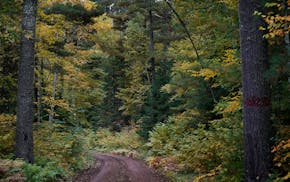ELY, Minn. – Can you stand one more take on the "man versus bear" debate?
You hear a lot of women saying they'd rather be alone in the woods with a bear, not a man, because they considered the man to be more dangerous.
I always chose the man, because my interactions with men have generally been positive, and a man wandering through the woods seemed likely to be a hunter or a naturalist or just someone out enjoying nature. Someone reasonable. Someone more likely to harbor a save-the-maiden fantasy than a desire to harm. Bears, on the other hand, if they have it in their head to attack, there is little you could do but try to survive.
A recent visit to Ely's North American Bear Center changed my mind. Not that I think less of men, but that I think more of bears. Black bears, at least.
The Bear Center provides refuge to three black bears, at least one of whom would have been otherwise euthanized. There's Lucky, abandoned or orphaned as a cub, who was begging for food near Madison, Wis., and who came within an hour of being put down before a rescuer whisked him off to Ely. There's Tasha, fat, sleek, and gorgeous, discovered in 2015 in Kentucky trying to nurse on her dead mother, who was believed to have been hit by a vehicle. And Holly, separated from her mother during an Arkansas fire, and who had slipped off to hibernate before our visit.
The bears were fascinating, delicately lipping up cranberries and shelling out nuts with their back teeth during our visit. We learned that their sense of smell is seven times stronger than that of a bloodhound, and that they can smell through an organ on the roof of their mouths.
In fact, sometimes they'll stand erect and open their mouths – which looks threatening, but it's really just to get a better sense of their surroundings, said Spencer Peter, assistant director and biologist at the center.
Hollywood trains them to stand like that for movies, he said. "But they'll dub in the sound."
The thing that most changed my mind about black bears was learning that North American Bear Center researchers have never been able to provoke an attack, not even from a mama bear with cubs. Lynn Rogers, the center's founder who has been researching black bears for most of his 87 years, even tried to provoke an attack by picking up a cub, Peter said.
"She still wouldn't," Peter said. "They were more likely to grab the other cubs and leave."
During our visit, a wildlife educator told our group that black bears have a prey, not predator, mindset. They were once fed upon by fierce predators like giant short-faced bears, dire wolves, and saber-toothed cats, which lived in North America for hundreds of thousands of years before going extinct about 10,000 years ago.
"None of those animals could climb, so the black bear could flee up a tree," Peter said.
Ironically, the shy, timid black bears were the ones to survive, whereas the bolder bears succumbed to predators, Peter says. The shy bears passed their genes on to their offspring, resulting in today's timid animals. Climbing a tree remains their go-to escape route.
They're also pretty easy to chase off. A billowing black plastic garbage bag will send them scampering from a campsite.
It's amazing how a little education is able to change a person's mind about a perceived threat.
Much of what we think we know about black bears wasn't challenged until Rogers began doing his research. Bear attack stories make for sensational reading. Humans like to be scared. Fear sells. We like to have something to fight, something that keeps us on guard, something that makes us shudder. After all, as Peter points out, it's more fun to tell about the bear that broke through your cabin window and ate all the sandwiches than about the bear that ran off into the brush the minute you pulled into your driveway.
But bears suffer the price for the horror stories, sometimes ending up dead, although Peter thinks that the presence of the Bear Center has helped save their lives.
People think that when bears pop their jaws or clack their teeth that they're being aggressive, whereas it really indicates that they're feeling anxious.
When you learn that, your own fear melts. How can you hate or fear something that is so afraid of you? When fear subsides, compassion begins.
Black bears do sometimes kill people. There are 750,000 in North America, and they kill less than one person per year on average. Most fatal black bear encounters take place in remote areas, by bears that may have never seen a human. You are more likely to die from bee or hornet stings or dog attacks, Peter says.
Men ages 18 to 24 are 167 times more likely to kill someone than a black bear would be, the Bear Center says.
So. Black bear versus man in the woods?
You know, I would be comfortable with either.

Tolkkinen: Fergus Falls priest who studied with Pope Leo says he has good hearing 'to hear everyone'

Tolkkinen: Just when I was starting to lose myself in nature's grandeur, along came a motorcycle

Tolkkinen: On a three-day northern Minnesota tour, the grit and glory of our state became clear

Tolkkinen: Brainerd City Council should spend a night, or 30, sleeping outdoors


